Integrated Pest Management (IPM) is a holistic approach to pest control that emphasizes prevention, monitoring, and control with minimal environmental impact. Effective IPM requires well-trained staff who understand and implement its principles consistently. Training not only increases efficiency and safety but also enhances the overall success of pest management programs. This article explores the importance of IPM training for staff, its benefits, and practical steps for developing a comprehensive training program.
Importance of IPM Training
1. Enhanced Knowledge and Skills:
- Training equips staff with the knowledge of pest biology, behavior, and the latest IPM techniques. Understanding the intricacies of pest management allows staff to identify and address pest issues more effectively.
2. Consistency in Implementation:
- Consistent training ensures that all staff members follow standardized procedures, leading to uniform implementation of IPM practices across the organization. This consistency is crucial for maintaining an effective pest management program.
3. Regulatory Compliance:
- Proper training helps ensure compliance with health, safety, and environmental regulations. Understanding legal requirements and best practices in pest management is critical for maintaining certification and avoiding penalties.
Benefits of IPM Training
1. Increased Efficiency:
- Faster Response: Trained staff can quickly identify pest issues and implement appropriate control measures, reducing the time and resources spent on pest management.
- Effective Use of Tools: Training enables staff to use monitoring tools and technologies effectively, enhancing the accuracy and efficiency of pest detection and control.
2. Enhanced Safety:
- Safe Handling of Pesticides: Training on safe handling and application of pesticides reduces the risk of accidents and exposure to harmful chemicals. This is particularly important in sensitive environments like schools, hospitals, and food processing facilities.
- Non-Chemical Methods: Understanding and implementing non-chemical control methods help minimize pesticide use, promoting a safer environment for staff and occupants.
3. Cost Savings:
- Efficient pest management reduces the need for costly treatments and repairs associated with pest damage. Training helps staff implement preventive measures effectively, reducing long-term costs.
4. Improved Environmental Impact:
- Training in IPM promotes the use of environmentally friendly pest control methods, reducing the environmental footprint of pest management activities. Staff learn to integrate biological controls, habitat manipulation, and other sustainable practices.
Developing an IPM Training Program
1. Assess Training Needs:
- Conduct a needs assessment to identify specific knowledge gaps and training requirements of your staff. This helps tailor the training program to address the unique challenges and needs of your organization.
2. Create Training Materials:
- Develop comprehensive training materials, including manuals, presentations, and hands-on activities. Materials should cover IPM principles, pest identification, monitoring techniques, control strategies, and safety protocols.
3. Implement a Training Schedule:
- Schedule regular training sessions to ensure continuous education and skill development. Initial training should be followed by periodic refresher courses to keep staff updated on new techniques and regulations.
4. Hands-On Training and Demonstrations:
- Include practical, hands-on training sessions where staff can practice pest identification, monitoring, and control techniques. Demonstrations by experienced professionals can enhance learning and retention.
5. Evaluate Training Effectiveness:
- Use assessments, feedback forms, and performance reviews to evaluate the effectiveness of the training program. Continuous evaluation helps identify areas for improvement and ensures that training objectives are being met.
6. Engage with Experts:
- Collaborate with pest management professionals and extension services to provide expert training and insights. External trainers can offer valuable perspectives and up-to-date information on best practices and innovations in IPM.
IPM training for staff is essential for increasing the efficiency and safety of pest management practices. By enhancing knowledge, ensuring consistent implementation, and promoting regulatory compliance, training programs can significantly improve pest control outcomes. Developing a comprehensive training program that includes hands-on practice, regular updates, and expert engagement ensures that staff are well-equipped to manage pests effectively and sustainably.
To know more about A&B’s services, please visit the A&B’s website (www.abpestsolutions.com.ph) or Facebook Page (https://www.facebook.com/ABPestSolutions/) to know more about their services. A&B also disinfects workplaces or houses to kill COVID-19 Virus.
You may also contact: +63 905 496 4550 and +63 951 062 4830
A&B Professional Pest Solutions Corporation is located at the Ground Floor of Monterey Building at Genesis St., Centro de San Lorenzo, Santa Rosa, 4026 Laguna, Philippines

